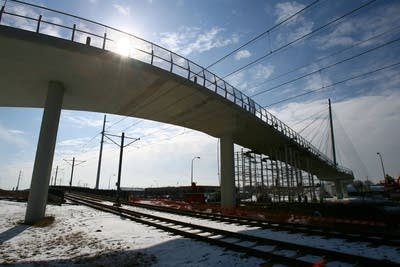Sabo bridge report recommends system to reduce vibrations

A final report released Friday recommends that a cable damping system be installed on the Sabo bike and pedestrian bridge in Minneapolis to prevent further damage.
According to the engineering firm that conducted the study, wind-induced cable vibrations caused a pair of cables to fall from the bridge in February. It also found that the bridge designer decided that a damping system to reduce vibrations was not necessary.
The Illinois-based engineering firm Wiss, Janney, Elstner Associates Inc. found that in addition to the vibrations, several other factors damaged two diaphragm plates that fasten cables to the bridge. The report found that the ¾-inch thick steel plate that completely broke and fell from the bridge several months ago was not properly aligned with the angle of the cable it supported. The misalignment, in combination with extreme temperature changes, led to stress cracks in the plate.
However, Brian Santosuosso, a project manager at Wiss, Janney, Elstner Associates says the repeated stresses caused by vibrating cables ultimately caused the plate to fail.
Create a More Connected Minnesota
MPR News is your trusted resource for the news you need. With your support, MPR News brings accessible, courageous journalism and authentic conversation to everyone - free of paywalls and barriers. Your gift makes a difference.
"We understand that static stresses are elevated due to the misalignment. The fracture was still related to cyclic stresses. And so it can have — the misalignment — can have an effect on how the fracture or the cracks grow. But we're saying they would have occurred anyway."
Santosuosso said the misalignment was caused by how the plate was fabricated, not how it was installed or designed. The plates were made by an Illinois based-company called PDM Bridge LLC, he said. According to the report, steel components for the bridge were shop-inspected by MnDOT. Neither PDM nor MnDOT immediately responded to calls for comment.
The five-year-old Sabo bridge is supported by 18 pairs of metal cables and was designed by URS Corporation. The San Francisco-based company is one of the largest engineering, design and construction firms in the world and has designed other cable-stayed bridges around the country. URS also consulted on the Interstate 35W bridge which fell in 2007. While URS did not design or build that bridge, it did agree to pay more than $50 million to settle lawsuits stemming from the collapse.

According to the report, URS considered cable vibrations in the design, but waited until the bridge was built before deciding whether a damping system to reduce cable vibrations was needed. Santosuosso says URS engineers measured cable vibrations nine times over a one-month period.
"That information was reported to URS engineers in the office. And they determined that based on what was reported, cable vibrations didn't appear to be an issue," Santosuosso said.
He says aside from the susceptibility of the plates to damage from wind-induced vibrations, URS' bridge design is sound. A URS spokesperson declined to be interviewed for this story but released a statement saying the company is studying the report and is particularly interested in examining "factors that did not involve our company, such as the misalignment of connection plates and defective welds."
The report from Wiss, Janney Elstner recommends a cable damping system to cut down on vibrations. One way to stabilize the cables is to tie them together with a series of other cables, Santosuosso said. The report also recommends reinforcing the diaphragm plates.
A spokesman for the city of Minneapolis said city engineers have not yet decided which retrofit options to implement. They are also considering whether to ask URS to help pay for the repairs.
The Metropolitan Council is considering URS for a nearly $100 million contract for the Southwest Light Rail project between Minneapolis and Eden Prairie. The Met Council is conducting a due diligence report on the URS bid. A Met Council spokesperson said the council will use the Sabo bridge study to inform the Council's investigation.


